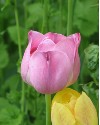Navigation boxes
This section is used to demonstrate how the content relation engine can be utilized in oder to create a kind of additional local navigation based on categories.
All the contents are assigned to a single category and at each page, there is a list box displayed linking to all other contents of the same category.
Lilaceous Plants
Recent news
Transportationbag for Christmastrees
Dec 10, 2010

Since this season, carrying bags for christmas trees are available.
The advantage of these bags is clear. Well stored trees cannot soil cars, clothes and houses. But this bag is also useful for a needle-free removement of the tree. The manufacturer offers also the possibility to print advertisements on the bags- this can ba a good campaign for the christmastree vendors.
Tulip
Tulipa, commonly called tulip, is a genus of about 150 species of bulbous flowering plants in the family Liliaceae.
The species are perennials from bulbs, the tunicate bulbs often produced on the ends of stolons and covered with glabrous to variously hairy papery coverings. The species include short low-growing plants to tall upright plants, growing from 10 to 70 centimeters (4–27 in) tall. They can even grow in the cold and snowy winter. Plants typically have 2 to 6 leaves, with some species having up to 12 leaves. The cauline foliage is strap-shaped, waxy-coated, usually light to medium green and alternately arranged. The blades are somewhat fleshy and linear to oblong in shape. The large flowers are produced on scapes or subscapose stems normally lacking bracts. The stems have no leaves to a few leaves, with large species having some leaves and smaller species have none.
Typically species have one flower per stem but a few species have up to four flowers. The colorful and attractive cup shaped flowers have three petals and three sepals, which are most often termed tepals because they are nearly identical. The six petaloid tepals are often marked near the bases with darker markings. The flowers have six basifixed, distinct stamens with filaments shorter than the tepals and the stigmas are districtly 3-lobed. The ovaries are superior with three chambers. The 3 angled fruits are leathery textured capsules, ellipsoid to subglobose in shape, containing numerous flat disc-shaped seeds in two rows per locule.
This article uses material from the Wikipedia article Tulip and is licensed under the GNU Free Documentation License.



